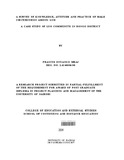| dc.contributor.author | Mbai, Francis O | |
| dc.date.accessioned | 2013-04-27T08:50:51Z | |
| dc.date.available | 2013-04-27T08:50:51Z | |
| dc.date.issued | 2008 | |
| dc.identifier.citation | PGD-PPM | en |
| dc.identifier.uri | http://erepository.uonbi.ac.ke:8080/xmlui/handle/123456789/17291 | |
| dc.description | Post-graduate diploma project planning | en |
| dc.description.abstract | Recent publications have reported an association between the lack of male circumcision and
sexual transmission of HIV. The government of Kenya is in the process of rolling out a policy
of universal male circumcision as a part of basic health care service with an aim of controlling
the spread of HIV infection. According to Luo opinion leaders, male circumcision cannot be
introduced to the community as a government policy without consultation. There is scanty
information on what the common members of the community say about male circumcision.
Information to post the community stand is required.
This study is aimed at determining possible barriers to male circumcision as a method of risk
reduction to HIV infection among the Luo community in Rongo district by evaluating the
knowledge, attitude and practice of male circumcision among Luo community living in
district.
This is a cross-sectional study which intends to describe the level of knowledge, attitude and
the practices of the study population on male circumcision as a method of HIV prevention
All (100%) of the respondents were aware of the three common modes of HIV transmission
and methods prevention of HIV. However, only 101 (51.8%) thought that male circumcision
could reduce risk of HIV transmission .The study found out that there was a significant (P-value <
0.05) change of attitude towards male circumcision among the youths, male guardians
and the cultural elders after they were informed that Me can help reduce heterosexual HIV
transmission . In conclusion, this study demonstrates that circumcision services for male
children among the luo community would be highly acceptable. Over 74% of the participants
felt that the best age for circumcision is after 6 years. IT is recommended that parents in
Rongo district should be offered the option of hospital-based circumcision for their male
children to protect them from the acquisition of HIV | en |
| dc.description.sponsorship | University of Nairobi | en |
| dc.language.iso | en | en |
| dc.title | A survey of knowledge, attitude and practice of male circumcision among Luo: a case study of Luo community in Rongo district | en |
| dc.type | Thesis | en |
| local.publisher | University of Nairobi, College of Education and External Studies | en |

